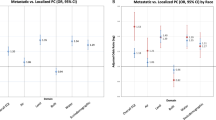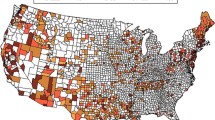Abstract
Background
Prostate cancer (PrCA) incidence in South Carolina (SC) exceeds the national average, particularly among African Americans (AAs). Though data are limited, low environmental zinc exposures and down-regulation of prostatic zinc transporter proteins among AAs may explain, in part, the racial PrCA disparity.
Methods
Age-adjusted PrCA rates were calculated by census tract. Demographic data were obtained from the 1990 census. Hazardous waste site locations and soil zinc concentrations were obtained from existing federal and state databases. A geographic information system and Poisson regression were used to test the hypothesis that census tracts with reduced soil zinc concentrations, elevated groundwater use, or more agricultural or hazardous waste sites had elevated PrCA risks.
Results
Census tracts with high groundwater use and low zinc concentrations had higher PrCA rate ratios (RR: 1.270; 95% confidence interval: 1.079, 1.505). This effect was not more apparent in areas populated primarily by AAs.
Conclusion
Increased PrCA rates were associated with reduced soil zinc concentrations and elevated groundwater use, although this observation is not likely to contribute to SC’s racial PrCA disparity. Statewide mapping and statistical modeling of relationships between environmental factors, demographics, and cancer incidence can be used to screen hypotheses focusing on novel PrCA risk factors.


Similar content being viewed by others
Abbreviations
- PrCA:
-
Prostate cancer
- SC:
-
South Carolina
- AA:
-
African-American
- EA:
-
European-American
- PSA:
-
Prostate-specific antigen
- GIS:
-
Geographic information system
- RR:
-
Rate ratio
- SCCCR:
-
South Carolina Central Cancer Registry
- DHEC:
-
Department of Health and Environmental Control
- USGS:
-
United States Geological Survey
- CERCLA:
-
Comprehensive Environmental Response, Compensation, and Liability Act
- EPA:
-
Environmental Protection Agency
- ppm:
-
Parts per million
- ICP:
-
Inductively coupled plasma
- SIR:
-
Standardized incidence ratio
- CI:
-
Confidence interval
- CAR:
-
Conditional autoregressive
- MCMC:
-
Markov chain Monte Carlo
References
Jemal A, Siegel R, Ward E, Murray T, Xu J, Thun MJ (2007) Cancer statistics. CA Cancer J Clin 57(1):43–66
Morton RA (1994) Racial differences in adenocarcinoma of the prostate in North American men. Urology 44(5):637–642. doi:10.1016/S0090-4295(94)80196-7
Pienta KJ, Demers R, Hoff M, Kau TY, Montie JE, Severson RK (1995) Effect of age and race on the survival of men with prostate cancer in the metropolitan Detroit tricounty area, 1973 to 1987. Urology 45(1):93–100. doi:10.1016/S0090-4295(95)96996-9
United States Census Bureau American Community Survey (2006) Data profile highlights. South Carolina
US Cancer Statistics Working Group (2007) United States Cancer Statistics: 2004 Incidence and Mortality. US DHHS/CDC/NIH-NCI, Atlanta, GA
Drake BF, Keane TE, Mosley CM et al (2006) Prostate cancer disparities in South Carolina: early detection, special programs, and descriptive epidemiology. J S C Med Assoc 102:241–249
Allen NE, Sauvaget C, Rodddam AW et al (2004) A prospective study of diet and prostate cancer in Japanese men. Cancer Causes Control 15:911–920. doi:10.1007/s10552-004-1683-y
Hebert JR, Ghumare SS, Gupta PC (2006) Stage at diagnosis and relative differences in breast and prostate cancer incidence in India: and comparison to the United States. Asian Pac J Cancer Prev 7(6):547–555
Thompson IM, Tangen CM, Tolcher A, Crawford ED, Eisenberger M, Moinpour CM (2001) Association of African-American ethnic background with survival in men with metastatic prostate cancer. J Nat Cancer Inst 93:219–225. doi:10.1093/jnci/93.3.219
Deutsch E, Maggiorella L, Eschwege P, Bourhis J, Soria JC, Abdulkarim B (2004) Environmental, genetic, and molecular features of prostate cancer. Lancet 5:303–313. doi:10.1016/S1470-2045(04)01468-8
Gilligan T (2005) Social disparities and prostate cancer: mapping the gaps in our knowledge. Cancer Causes Control 16:45–53. doi:10.1007/s10552-004-1291-x
Sanderson M, Coker AL, Logan P, Zheng W, Fadden MK (2004) Lifestyle and prostate cancer among older African-Americans and Caucasian men in South Carolina. Cancer Causes Control 15:647–655. doi:10.1023/B:CACO.0000036172.63845.d4
Hsieh K, Albersten PC (2003) Populations at high risk for prostate cancer. Urol Clin N Am 30:669–676. doi:10.1016/S0094-0143(03)00058-2
Faroon OM, Williams M, O’Connor R (1994) A review of the carcinogenicity of chemicals most frequently found at National Priorities List sites. Toxicol Ind Health 10(3):203–230
Navarro Silvera SA, Rohan TE (2007) Trace elements and cancer risk: a review of the epidemiologic evidence. Cancer Causes Control 18(1):7–27. doi:10.1007/s10552-006-0057-z
Bostwick DG, Burke HB, Djakiew D et al (2004) Human prostate cancer risk factors. Cancer 101(10 Suppl):2371–2490. doi:10.1002/cncr.20408
Franklin RB, Costello LC (2007) Zinc as an anti-tumor agent in prostate cancer and in other cancers. Arch Biochem Biophys 463(2):211–217. doi:10.1016/j.abb.2007.02.033
Costello LC, Liu Y, Zou J, Franklin RB (1999) Evidence for a zinc uptake transporter in human prostate cancer cells which is regulated by prolactin and testosterone. J Biol Chem 274:17499–17504 June 18
Franklin RB, Feng P, Milon B et al (2005) hZIP1 zinc uptake transporter down regulation and zinc depletion in prostate cancer. Mol Cancer 4(32):1–13
Iguchi K, Hamatake M, Ishida R et al (1998) Induction of necrosis by zinc in prostate carcinoma cells and identification of proteins increased in association with this induction. Eur J Biochem 253:766–770. doi:10.1046/j.1432-1327.1998.2530766.x
Rishi I, Baidouri H, Abbasi JA et al (2003) Prostate cancer in African-American men is associated with down-regulation of zinc transporters. Appl Immunohistochem Mol Morphol 11:252–260
[ATSDR] Agency for Toxic Substances and Disease Registry (2005) Toxicological profile for zinc. U.S. Department of Health and Human Services, Public Health Service
Environmental Protection Agency (EPA) (1980) Exposure and risk assessment for zinc. In: EPA440481016 PB85212009. U.S. Environmental Protection Agency, Office of Water Regulations and Standards (WH-553), Washington, DC
Kalbasi M, Racz GJ, Lewen-Rudgers LA (1978) Reaction products and solubility of applied zinc compounds in some Manitoba soils. Soil Sci Soc Am 125:55–64
Apak R (2006) Adsorption of heavy metal ions on soil surfaces and similar substances: theoretical aspects. In: Encyclopedia of surface and colloid science. Taylor and Francis, pp 484–509
van der Cruijsen-Koeter IW, Vis AN, Roobol MJ et al (2005) Comparison of screen detected and clinically diagnosed prostate cancer in the European randomized study of screening for prostate cancer, section Rotterdam. J Urol 174(1):121–125. doi:10.1097/01.ju.0000162061.40533.0f
Environmental Protection Agency (EPA) (1989) Risk assessment guidance for superfund, vol 1, Human health evaluation manual, Part A. Interim Final, Office of Emergency and Remedial Response, December
Canova JL (1999) Elements in South Carolina inferred background soil and stream sediment samples. S C Geol 41:11–25
Clemson University Extension: Agriculture Service Laboratory. http://www.clemson.edu/agsrvlb/index.htm
Polednak AP (1997) Stage at diagnosis of prostate cancer in Connecticut by poverty and race. Ethn Dis 7:215–220
South Carolina Census Shape File. Obtained from: South Carolina Department of Health and Environmental Control
United States Geological Survey (USGS) Frequently Asked Questions concerning NURE HSSR Data
South Carolina Central Cancer Registry Incidence and Mortality (SCCCR) (2006) Office of Public Health Statistics and Information Services, Department of Health and Environmental Control
Chu KC, Tarone RE, Freeman HP (2003) Trends in prostate cancer mortality among black men and white men in the United States. Cancer 97(6):1507–1516. doi:10.1002/cncr.11212
Liu L, Cozen W, Bernstein L, Ross RK, Deapen D (2001) Changing relationship between socioeconomic status and prostate cancer incidence. J Natl Cancer Inst 93(9):705–709. doi:10.1093/jnci/93.9.705
SCBCB (2008) South Carolina Statistical Abstract 2008. South Carolina Budget and Control Board, Office of Research and Statistics, Columbia, SC
Rothman KJ, Greenland S (1989) Modern epidemiology, 2nd edn. Lippincott Williams & Wilkins, Philadelphia
Wilson EB, Hilferty MM (1931) The distribution of chi-square. Proc Natl Acad Sci USA 17:684–688. doi:10.1073/pnas.17.12.684
Solymosi N, Reiczigel J, Harnos A et al (2006) A Multitask PostGIS based Vet GIS Framework. In: 1st OIE International Conference Use of GIS in Veterinary Activities, October 2006, Silvi Marina, Abruzzo, Italy. http://epi.univet.hu/portal/sn/kutatas/epidemiologia/terbeli-epidemiologia/betegseg-terkepezes/gisconference/oiegis.pdf
Hebert JR, Hurley TG, Olendzki B, Ma Y, Teas J, Hampl JS (1998) Nutritional and socioeconomic factors in relation to prostate cancer mortality: a cross-national study. J Natl Cancer Inst 90:1637–1647. doi:10.1093/jnci/90.21.1637
Nelson WG, DeWeese TL, DeMarzo AM (2002) The diet, prostate inflammation, and the development of prostate cancer. Cancer Metastasis Rev 21:13–16
Lichtenstein P, Holm NV, Verkasalo PK et al (2000) Environmental and heritable factors in the causation of cancer—analyses of cohorts of twins from Sweden, Denmark, and Finland. N Engl J Med 343:78–85. doi:10.1056/NEJM200007133430201
Waalkes MP, Rehm S (1992) Carcinogenicity of oral cadmium in the male-Wistar (WF/NCr) rat: effect of chronic dietary zinc deficiency. Fundam Appl Toxicol 19:5–12. doi:10.1016/0272-0590(92)90089-Z
Vogt TM, Ziegler RG, Graubard BI (2003) Serum selenium and risk of prostate cancer in U.S. blacks and whites. Int J Cancer 103:664–670. doi:10.1002/ijc.10866
Elmes ME (1977) Apoptosis in the small intestine of zinc-deficient and fasted rats. J Pathol 123(4):219–223. doi:10.1002/path.1711230404
Liang JY, Liu YY, Zou J, Franklin RB, Costello LC, Feng P (1999) Inhibitory effect of zinc on human prostatic carcinoma cell growth. Prostate 40(3):200–207. doi:10.1002/(SICI)1097-0045(19990801)40:3<200::AID-PROS8>3.0.CO;2-3
Achanzar WE, Diwan BA, Liu J, Quader ST, Webber MM, Waalkes MP (2001) Cadmium-induced malignant transformation of human prostate epithelial cells. Cancer Res 61:455–458
Lonnerdal B (2000) Dietary factors influencing zinc absorption. J Nutr 130:1378S–1383S
Reed JM, Stitch SR (1973) The uptake of testosterone and zinc in vitro by the human benign hypertrophic prostate. J Endocrinol 58(5):483–486
Waalkes MP, Coogan TP, Barter RA (1992) Toxicological principles of metal carcinogenesis with special emphasis on cadmium. Crit Rev Toxicol 22(3,4):175–201
Oliver MN, Matthews KA, Siadaty M, Hauck FR, Pickle LW (2005) Geographic bias related to geocoding in epidemiologic studies. Int J Health Geogr 4:29. doi:10.1186/1476-072X-4-29
Krieger N, Waterman P, Lemieux K, Zierler S, Hogan JW (2001) On the wrong side of the tracts? Evaluating the accuracy of geocoding in public health research. Am J Public Health 91(7):1114–1116
Le Marchand L, Kolonel LN, Hankin JH, Yoshizawa CN (1989) Relationship of alcohol consumption to diet: a population-based study in Hawaii. Am J Clin Nutr 49:567–572
The Nutrition Data System for Research (NDS-R Version 4.03_31) developed by the Nutrition Coordinating Center (NCC), University of Minnesota, Minneapolis, MN
South Carolina Office of Research and Statistics (2005) South Carolina Rural Health Report. SC Budget and Control Board, Columbia, SC
Grubesic TH, Matisziw TC (2006) On the use of ZIP codes and ZIP code tabulation areas (ZCTAs) for the spatial analysis of epidemiological data. Int J Health Geogr 5:58. doi:10.1186/1476-072X-5-58
Krieger N, Waterman P, Chen JT, Soobader MJ, Subramanian SV, Carson R (2002) Zip code caveat: bias due to spatiotemporal mismatches between zip codes and US census-defined geographic areas—the Public Health Disparities Geocoding Project. Am J Public Health 92(7):1100–1102
Acknowledgments
Research Career Development Award, Department of Veteran’s Affairs VISN-7, Charleston, South Carolina to J. B. B.; National Cancer Institute, Community Networks Program (1 U01 CA114601-01 to J. R. H.).
Author information
Authors and Affiliations
Corresponding author
Rights and permissions
About this article
Cite this article
Wagner, S.E., Burch, J.B., Hussey, J. et al. Soil zinc content, groundwater usage, and prostate cancer incidence in South Carolina. Cancer Causes Control 20, 345–353 (2009). https://doi.org/10.1007/s10552-008-9248-0
Received:
Accepted:
Published:
Issue Date:
DOI: https://doi.org/10.1007/s10552-008-9248-0




